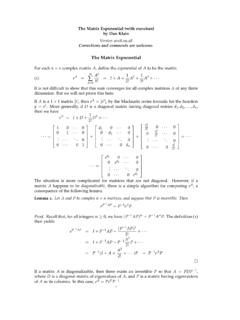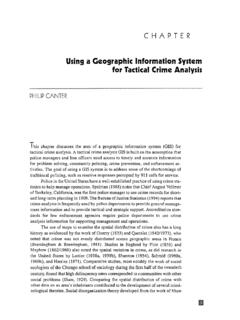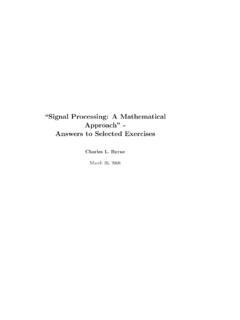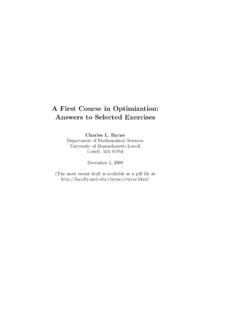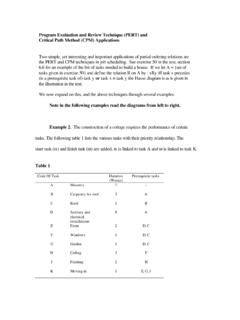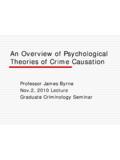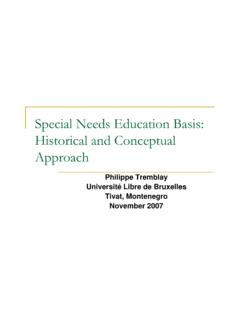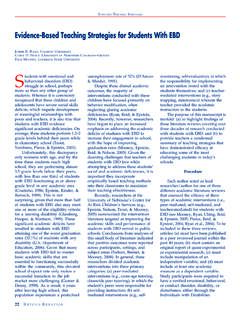Transcription of Promoting Positive Social Interactions in an Setting for ...
1 National Association of Special Education Teachers NASET LD Report #7. Promoting Positive Social Interactions in an Inclusion Setting for Students with learning disabilities Introduction If you are working or going to work as either a general education or special education teacher in an inclusion classroom you will be involved a myriad of Positive and challenging experiences. None of these will be more rewarding than helping children with special needs develop Positive Social Interactions with their peers. One of the components of successful of inclusion is the degree to which the student with a disability feels a part of the general education classroom. The feeling of belonging positively affects the student s self-image and self-esteem, motivation to achieve, speed of adjustment to the larger classroom and new demands, general behavior, and general level of achievement.
2 The impact of the new student on the general classroom is a major consideration for inclusion planners. Fostering Positive Social relationships between students with disabilities and their peers requires the preparation of nondisabled peers in the classroom so that they understand the needs of their new classmates. Teachers may use many strategies to help the student achieve a sense of belonging to the class and school. One of the most critical things an inclusion classroom teacher must do is establish and maintain a Positive and supportive classroom atmosphere. Students are more likely to follow directions, work hard, and exhibit Positive classroom behavior when they feel wanted and appreciated by the teacher. This may be especially true of particularly difficult students, who may not trust adults, and who may feel that most teachers are out to get them.
3 What is Inclusion? Inclusion involves keeping special education students in general education classrooms and bringing the support services to the child, rather than bringing the child to the support services. Inclusion is a term which expresses commitment to educate each child, to the maximum extent appropriate, in the school and classroom he or she would otherwise attend. It involves bringing the support services to the child (rather than moving the child to the services) and requires only that the child will benefit from being in the class (rather than having to keep up with the other students). Proponents of inclusion generally favor newer forms of education service delivery (Wisconsin Education Association Council, 2001). The term inclusion does not appear in federal law or regulations, but its use to refer to the concept of integration of students with disabilities has become standard, and many court cases NASET | Promoting Positive Social Interactions in an Inclusion Setting for Students with 1.
4 learning disabilities National Association of Special Education Teachers use the term. In the literature, one will encounter "inclusion," "full inclusion," "integration," "full integration," "inclusive schools," "inclusive education," and unified system"--all terms used to describe the philosophy and the practices of the full participation of students with disabilities in regular education classrooms (Price, Mayfield, McFadden, and Marsh, 2001). There seem to be two general approaches to inclusion: inclusion and full inclusion (Price, Mayfield, McFadden, and Marsh, 2001). Inclusion represents a belief that students with disabilities belong in regular program of the school where special services are available to support the effort.
5 Full inclusion apparently has two variations: (a) the belief that special education should be dismantled, and (b) special education should exist only in the regular classroom. Advocates of full inclusion are sometimes referred to disparagingly as "radical" inclusionists. These approaches form the boundaries of the debate about inclusion. (Price, Mayfield, McFadden, and Marsh, 2001). Full inclusion means that all students, regardless of handicapping condition or severity, will be in a regular classroom/program full time. All services must be taken to the child in that Setting (Wisconsin Education Association Council, 2001). Principles of Effective Inclusion According to Salend (2001), there are four principles of effective inclusion: 1.
6 Effective inclusion improves the educational system for all students by placing them together in general education classrooms-regardless of their learning ability, race, linguistic ability, economic status, gender, learning style, ethnicity, cultural background, religion, family structure, and sexual orientation. Inclusionary schools welcome, acknowledge, affirm, and celebrate the value of all learners by educating them together in high-quality, age appropriate general education classrooms in their neighborhood schools. 2. Effective inclusion involves sensitivity to and acceptance of individual needs and differences. Educators cannot teach students without taking into account the factors that shape their students and make them unique.
7 In inclusive classrooms, all students are valued as individuals capable of learning and contributing to society. They are taught to appreciate diversity and to value and learn from each other s similarities and differences 3. Effective inclusion requires reflective educators to modify their attitudes, teaching and classroom management practices, and curricula to accommodate individual needs. In inclusive classrooms, teachers are reflective practitioners who are flexible, responsive, and aware of students needs. They think critically about their values and beliefs and routinely examine their own practices for self-improvement and to ensure that all students needs are met. 4. Effective inclusion is a group effort; it involves collaboration among educators, other professionals, students, families, and community agencies.
8 The support and services that students need are provided in the general education classroom. People work cooperatively, reflectively, sharing resources, responsibilities, skills, decisions, and advocacy for students benefit. NASET | Promoting Positive Social Interactions in an Inclusion Setting for Students with 2. learning disabilities National Association of Special Education Teachers Why are Social Skills Important? Social competence is the degree to which students are able to establish and maintain satisfactory interpersonal relationships, gain peer acceptance, establish and maintain friendships, and terminate negative or pernicious interpersonal relationships. Effective Social problem solving requires reading one s own and others feelings, and being able to accurately label and express those feelings.
9 Such skills are aspects of Social and emotional learning (Zins, et al., 1998, p. 19). Well-developed Social skills can help youth with disabilities develop strong and Positive peer relationships, succeed in school, and begin to successfully explore adult roles such as employee, co-worker/colleague, and community member. Social skills also support the Positive development of healthy adult relationships with family members and peers. Hair, Jager, and Garrett (2002) observe that adolescents who have strong Social skills, particularly in the areas of conflict resolution, emotional intimacy, and the use of pro- Social behaviors, are more likely to be accepted by peers, develop friendships, maintain stronger relationships with parents and peers, be viewed as effective problem solvers, cultivate greater interest in school, and perform better academically (p.)
10 3). Adequate Social skills need to be acquired while students are still enrolled in school and further supported and refined in postsecondary, community, and work settings. Social Cognitive Skill Development Social relationships are an important aspect of the learning process and the classroom environment. Research has demonstrated that a significant proportion of students who fail to adjust socially to the classroom environment lack effective Social -problem-solving skills. Social problems include: poor ability to be empathetic to others perspectives poor impulse control inability to generate multiple and effective solutions to problems faced in the classroom Deficiencies in cognitive problem solving skills often lead to emotional and behavioral disorders requiring treatment.


